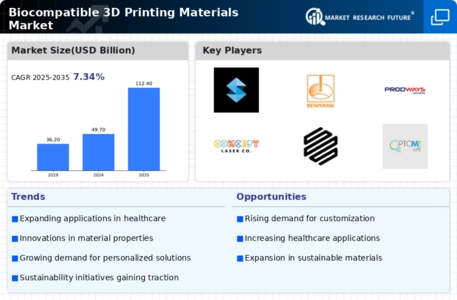North America : Innovation and Market Leadership
North America leads the Biocompatible 3D Printing Materials Market, holding a significant share of 5.5 in 2024. The region's growth is driven by advancements in healthcare technology, increasing demand for personalized medical solutions, and supportive regulatory frameworks. The FDA's proactive stance on 3D printing innovations further catalyzes market expansion, ensuring safety and efficacy in biocompatible materials.
The competitive landscape is robust, with key players like Stratasys, 3D Systems, and Formlabs spearheading innovation. The U.S. remains the largest market, supported by a strong manufacturing base and extensive R&D investments. Canada and Mexico are also emerging as significant contributors, enhancing the region's overall market dynamics.
Europe : Regulatory Support and Growth
Europe's Biocompatible 3D Printing Materials Market is valued at 3.5, reflecting a growing interest in sustainable and innovative healthcare solutions. The region benefits from stringent regulations that ensure high-quality standards, driving demand for biocompatible materials. Initiatives from the European Commission to promote advanced manufacturing technologies further bolster market growth, emphasizing sustainability and innovation.
Leading countries include Germany, France, and the UK, where companies like Materialise and EOS are making significant strides. The competitive landscape is characterized by a mix of established firms and startups, fostering innovation. The presence of key players and a strong regulatory framework positions Europe as a vital player in the global market.
Asia-Pacific : Rapid Growth and Adoption
The Asia-Pacific region, with a market size of 2.5, is witnessing rapid growth in the Biocompatible 3D Printing Materials Market. Factors such as increasing healthcare expenditure, a rising aging population, and advancements in 3D printing technology are driving demand. Governments are also investing in healthcare infrastructure, which supports the adoption of innovative materials in medical applications.
Countries like China, Japan, and India are at the forefront of this growth, with significant investments from local and international players. Companies such as HP and Nexa3D are expanding their presence, contributing to a competitive landscape that fosters innovation. The region's potential is further enhanced by collaborations between academia and industry, driving research and development in biocompatible materials.
Middle East and Africa : Emerging Opportunities and Challenges
The Middle East and Africa (MEA) region, with a market size of 0.89, is gradually emerging in the Biocompatible 3D Printing Materials Market. The growth is driven by increasing healthcare needs, particularly in countries like the UAE and South Africa, where there is a push for advanced medical technologies. However, challenges such as regulatory hurdles and limited infrastructure can impede rapid growth.
Despite these challenges, the competitive landscape is evolving, with local players and international companies exploring opportunities. The presence of key players is growing, and collaborations with healthcare providers are becoming more common. This region holds significant potential for future growth as investments in healthcare technology continue to rise.

















Leave a Comment